Berlin's main street

Unter den Linden is Berlin's most famous boulevard and is home to several of the German capital's most famous landmarks. The street stretches for 1,390 metres in the heart of the city, from Brandenburg Gate (Brandenburger Tor) to Museum Island (Museumsinsel). Its maximum width is 60 metres. Today, Unter den Linden is Berlin's main "calling card".
The name of the street means "under the lime trees" in German. It came about after Elector Friedrich Wilhelm I. decided to decorate the road along which he regularly travelled to his hunting grounds, the Tiergarten, in the 17th century. In 1647, 1,000 linden and 1,000 walnut trees were planted in six rows along the road following the Dutch model. At the time, the road was almost entirely outside the city walls.
The city grew steadily, and its border moved further and further away. Sophie Dorothea von Hannover, wife of the Elector, divided the unpopulated area along the road and sold the resulting land. This is how the suburb of Berlin (and later the city district) Dorotheenstadt with the houses of the court and wealthy citizens came into being.
Unter den Linden reached its heyday during the reign of King Frederick the Great of Prussia (Friedrich der Große). The king's court architect Georg Wenzeslaus von Knobelsdorff built the Forum Fridericianum, the current Bebelplatz, Opera House (Opernhaus), the Catholic Cathedral of St. Jadwig (Sankt-Hedwigs-Kathedrale), the Royal Library (Staatsbibliothek zu Berlin) and the Palais des Prinzen Heinrich (Palais des Prinzen Heinrich). In 1770, Frederick II decided to build up the avenue with formal buildings. For this purpose, 44 houses which did not meet the King's expectations were demolished. In their place were built 33 mansions for the nobility and wealthy citizens. At this time, Unter den Linden became the landmark of the Prussian capital.
After the victory over Napoleon in the 19th century, King Friedrich Wilhelm III decided to turn Unter den Linden into a triumphal avenue. The Brandenburg Gate with its famous quadriga and Pariser Platz, as well as the equestrian statue of Friedrichs des Großen in the middle of the street, became part of its architectural ensemble. During the 19th century the street was quickly filled with new buildings, shops, hotels, restaurants and office buildings. In 1880, a special "Linden" law came into force that prohibited building any taller than 22 m on the street, prescribed a maximum width of 60 m and a minimum number of 297 lindens in the street.
Since the end of the 19th century, Unter den Linden has been transformed from a boulevard into Berlin's central thoroughfare. In 1916, Germany's last emperor and King Wilhelm II of Prussia decided to build a tunnel under the street. Under the Nazis, all the linden trees on Unter den Linden were removed as they were in the way of the marching troops. The street was almost completely destroyed during the Second World War. During GDR times, Berliners called Unter den Linden 'the chicest cul-de-sac in the world' as it was the border zone between East and West Berlin. Most of the historic buildings on the street were restored in the 1960s. Today, lime trees are once again planted on Unter den Linden, under which the capital's residents and many tourists stroll.
Sightseeing on Unter den Linden
Among tourists, Unter den Linden is one of the most popular destinations in Berlin. There are indeed many sites of interest here.
Brandenburg Gate (Brandenburger Tor)

The Brandenburg Gate is the only one of Berlin's 18 city gates that has survived to some extent. In 1793, on the orders of King Friedrich Wilhelm II of Prussia, it was rebuilt as a triumphal arch in the Classicist style. From this gate begins Unter den Linden street. At the top of the Brandenburg Gate is the famous sculptural composition of the Quadriga, a foursome of four harnessed horses guided by Victoria, the goddess of victory. It is Berlin's most popular attraction. It is associated with many historical moments of both the city and the country as a whole.
Paris Square (Pariser Platz)
Paris Square is directly adjacent to the Brandenburg Gate. Originally the square was home to several palaces of the city's aristocracy. Today it houses official buildings such as the US Embassy (Botschaft der USA), the UN office, the French Embassy (Französische Botschaft) and banks. Paris Square is completely free of car traffic and has benches, flowerbeds and fountains.
Adlon Hotel (Hotel Adlon Kempinski)

The Hotel Adlon building closes in on the south side of Paris Square. It is one of the most famous and expensive hotels in Berlin, which today belongs to the Kempinski hotel chain. The modern hotel building was taken into use on 23 August 1997. The hotel inherits the tradition of the historic Hotel Adlon, which appeared here in 1907 and burned out completely in 1945.
Madame Tussauds Museum (Madame Tussauds Berlin)

Madame Tussauds Museum is located on the north side of Unter den Linden, near Place de Paris. You can see famous characters from German history: Karl Heinrich Marx, Sigmund Freud, Adolf Hitler, Pope Benedictus PP. XVI, Angela Dorothea Merkel, the writers Bertolt Brecht and Günter Wilhelm Grass, Albert Einstein and contemporary German cultural, political and television stars Heidi Klum, Oliver Rolf Kahn, Manuel Peter Neuer and others. A total of 120 celebrity figures are on display in Berlin's Madame Tussauds.
Embassy of the Russian Federation (Russische Botschaft in Berlin)
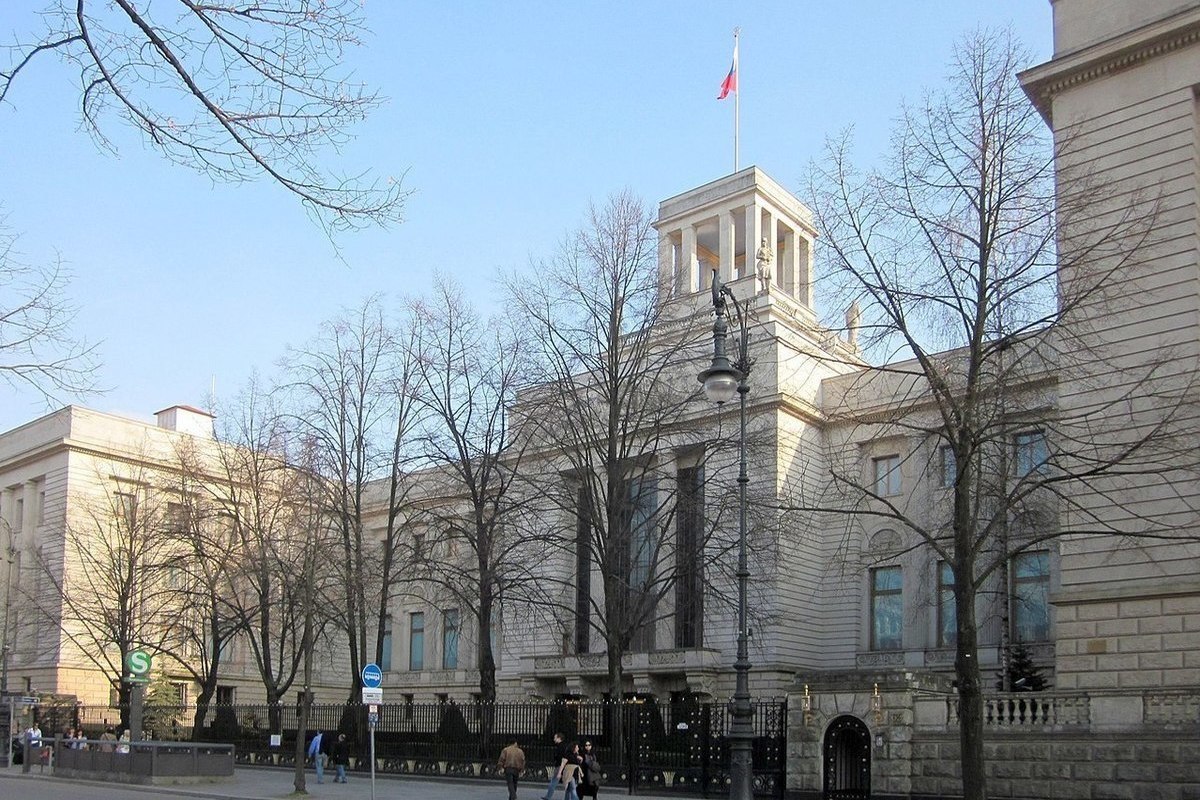
The Embassy of the Russian Federation is located in the heart of Unter den Linden. The building was not rebuilt after the devastation of World War II. Instead, a new complex in the Stalinist style (Socialist Classicism) was built between 1949 and 1951. The main building is adjoined by several administrative and residential buildings on Behrenstraße and Glinkastrasse. The entire building complex occupies an entire block in the centre of Berlin.
Equestrian statue of Frederick the Great (Reiterstandbild Friedrichs des Großen)

The equestrian statue of Frederick the Great, 13.5 metres high, is located in the centre of Unter den Linden in the street divide next to the Old Palace (Altes Palais). The sculpture, created in 1851, is considered the most important work of Christian Daniel Rauch, a German classicist sculptor. The people of Berlin ironically refer to this monument as "Old Fritz" (Alten Fritz). The sculpture stands on a rectangular pedestal measuring 7 metres by 9 metres at the base, consisting of two parts.
Crown Prince's Palace (Kronprinzenpalais)

The crown prince's palace was built in 1663 for the cabinet secretary Johann Martinz and changed owners several times. In 1732, after the Baroque palace was rebuilt by architect Philipp Gerlach, it was used as the residence of the crown prince and future king Friedrich II (Friedrich Wilhelm II) and his wife Elisabeth Christine von Braunschweig-Wolfenbüttel only for brief visits to Berlin. When Friedrich became king, he gave the palace to his brother August Wilhelm Prinz von Preußen. In 1919 the palace was transferred from the possession of the Prussian state to the Berlin's National Gallery (Nationalgalerie Berlin). The princely palace was fully destroyed during the Second World War and subsequently rebuilt in 1968 and began to be used to house visitors to the capital. Today, exhibitions and cultural events are held in the Palace of the Crown Princes.
The Princess Palace (Prinzessinnenpalais)

Princess Palace, the former Hohenzollern Palace adjacent to the Crown Prince's Palace, was built in 1733. In 1755, the Margrave of Brandenburg-Schwedt Heinrich Friedrich bought the palace. In 1788, the palace was acquired by the Hohenzollern dynasty. Johann Heinrich Gentz had the front façade of the palace built on Unter den Linden in 1811, and Karl Friedrich Schinkel had the arched gateway link the palace with the Crown Prince's Palace. After this alteration, Luise Auguste Wilhelmine Amalie von Preußen, daughter of King Friedrich Wilhelm III, settled here and the palace was named "Princess Palace". Until 1918, the palace housed members of the Prussian ruling dynasty and officials. In 1931, the Schinkel Museum was opened in the palace. During the restoration of the building in 1962-1964, only the exterior walls and the façade were preserved. The building now houses the "Unter den Linden opera house" (Opernpalais Unter den Linden) restaurant.
Berlin State Opera (Staatsoper Berlin)
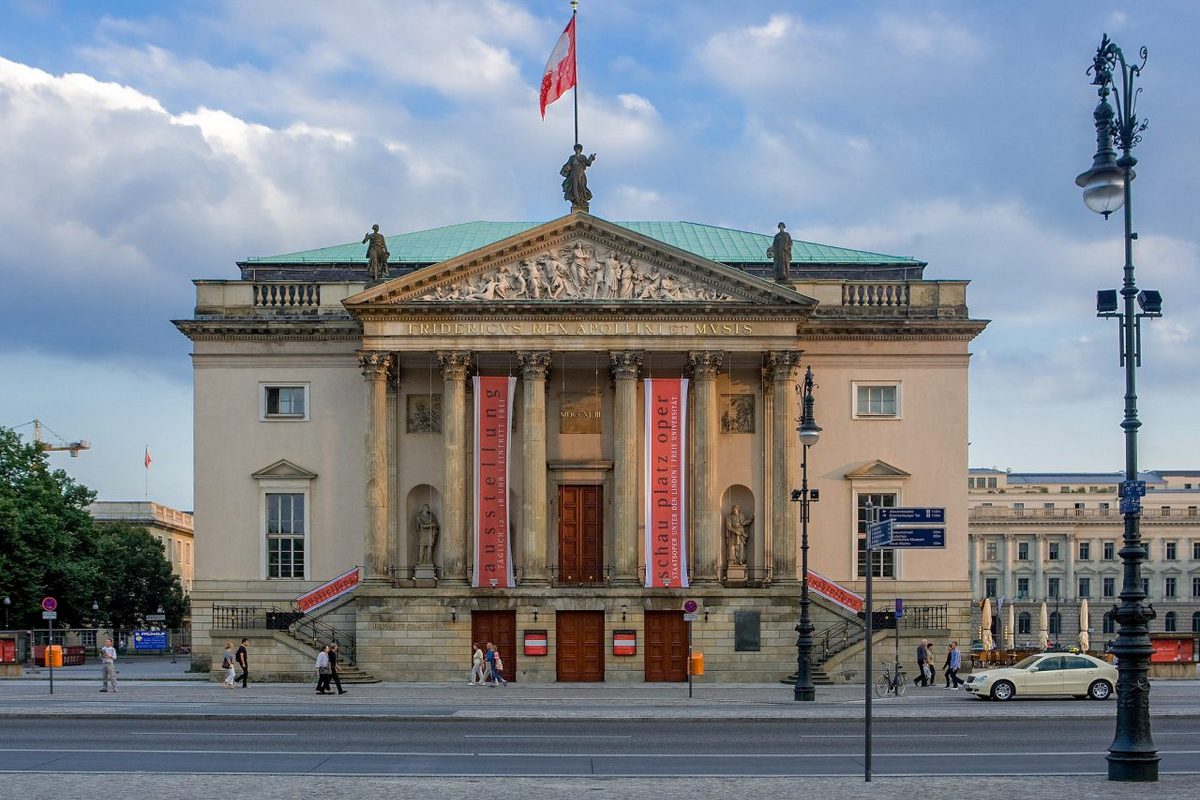
The Berlin State Opera, also called the German State Opera (Deutsche Staatsoper) or the State Opera House on Unter den Linden (Staatsoper Unter den Linden), is one of the oldest and largest musical theatres in Germany. The building was built in 1742 under Prussian King Frederick II and was originally the Royal Court Opera (Königliche Hofoper) — it was the first public theatre in Germany. Since 1992, the Berlin State Opera has been directed by the Israeli conductor and pianist Daniel Barenboim. The theatre's orchestra is the Berlin State Chapel (Staatskapelle Berlin).
The Old Palace (Altes Palais)
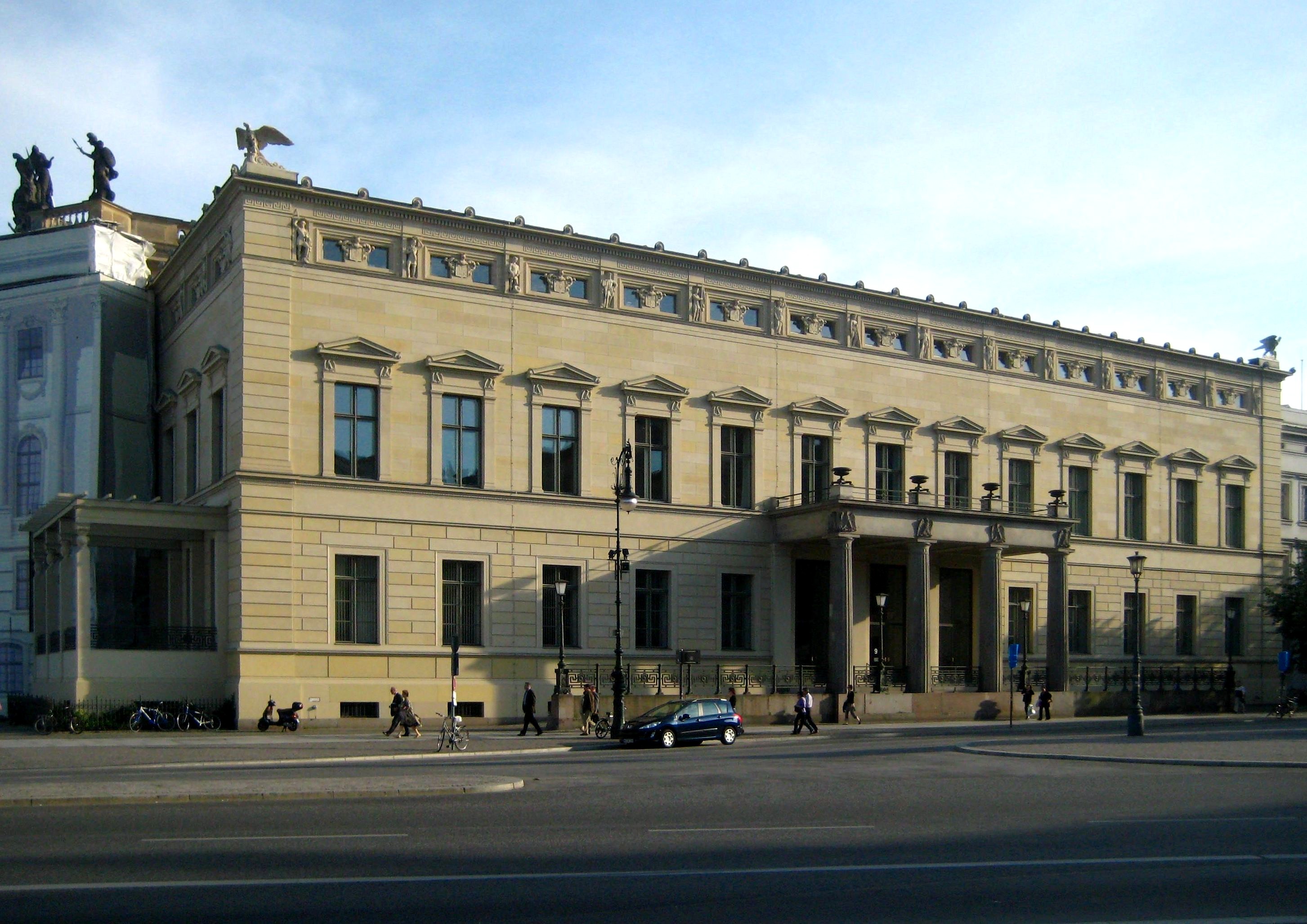
The Old Palace, located on the corner of Bebelplatz and Unter den Linden, was built in the Classical style between 1834 and 1837 to plans by Carl Ferdinand Langhans on the site of the 17th-century Swedish palace (Schwedtschen Palais). It was the home of Colonel von Weiler, commander of the Brandenburgian Electorate's artillery, from 1688 to 1692. In 1817, it was purchased by Count Tauentzien (Bogislav Friedrich Emanuel von Tauentzien), an infantry general and Prussian commander during the Napoleonic Wars. The palace was extensively rebuilt in the 19th century, and for 50 years it was the capital residence of King of Prussia and German Emperor Wilhelm I. Today the palace is used as the building of the Faculty of Law at Humboldt University Berlin (Humboldt-Universität zu Berlin).
Humboldt University (Humboldt-Universität zu Berlin)

On 16 August 1809, Wilhelm von Humboldt founded the oldest of Berlin's four universities. Friedrich Heinrich Ludwig von Preußen (brother of Frederick II of Prussia), the empty palace that was built in 1748-1766 by the court architect Georg Wenzeslaus von Knobelsdorff, was taken over by the university as its main building. In 1810 students began their studies here, of which only 256 were enrolled at that time. In 1828 it was named Friedrich Wilhelm University (Friedrich-Wilhelms-Universität zu Berlin) in honour of the Prussian king Friedrich Wilhelm III during whose reign it was founded. In the 19th century the university was one of Europe's major scientific centres. In 1949, the university was renamed after the Humboldt brothers and received its current name. In the winter of 2015-2016, the number of students was already 34,214 from more than 100 countries. Several Nobel Prize winners have been educated here, including the Dutch chemist Jacobus Henricus van't Hoff, professor of ancient history Theodor Mommsen, theoretical physicist Albert Einstein, theoretical physicist Max Karl Ernst Ludwig Planck and others.
Bebelplatz
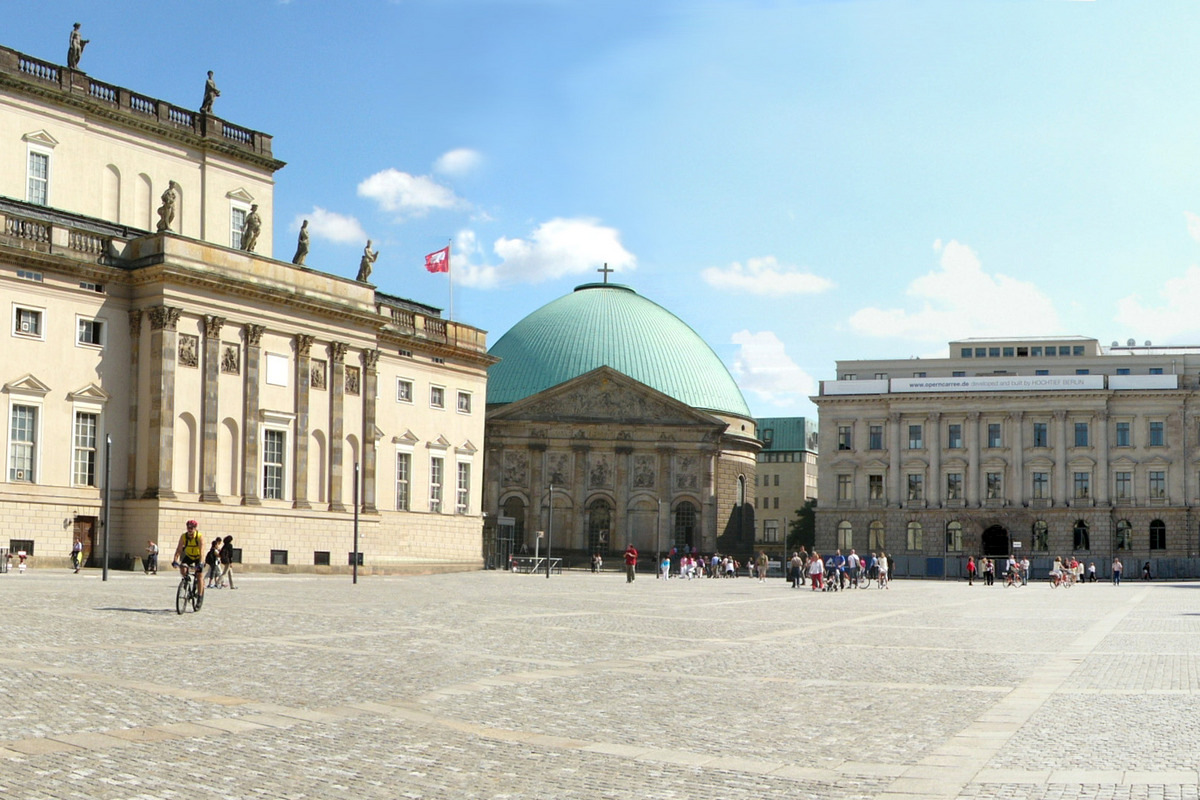
Bebel Square in the centre of Unter den Linden is the only square in the city centre whose facades look as they did before 1943. It appeared between 1741 and 1743 and was called Opernplatz — "square at the opera" — as the building of the Berlin Opera House (Staatsoper Berlin) was built there at the time. Between 1911 and 1947, the square was named after Emperor Franz Joseph — Kaiser-Franz-Josef-Platz. Under the Nazis, Bebelplatz became the site of the famous burning of over 20,000 books by about 400 "unwanted" authors on May 10, 1933. During the pre-war development of the square a complex of buildings with Prince Henry's Palace, an opera house, the Cathedral of St. Jadwiga (Sankt-Hedwigs-Kathedrale) and the royal library was erected, which was called Forum Fridericianum after King Frederick the Great. Since August 31, 1947, the square was named Bebelplatz (Bebel Square) in honour of Ferdinand August Bebel — the German and international labour activist — and it is under state protection. Since 2004 there has been a two-storey underground car park under the square, with a direct access to the State Opera. A reminder of the Nazi era is the memorial "Monument to burnt books" (Denkmal für verbrannte Bücher) or "The drowned library" (Versunkene Bibliothek) by Micha Ullmann.
Neue Wache

The Neue Wache ("New Guardhouse") is the former brig building which is now the main memorial to the victims of war and tyranny in Germany. It is a small building next to the Humboldt University on Unter den Linden. The Neue Wahe was built in 1816-1818 by the famous Prussian architect Karl Friedrich Schinkel as a guardroom for the Prussian Royal Guard and as a memorial to fallen soldiers from the Napoleonic wars. In 1931, the building was rebuilt according to the design of Heinrich Tessenow as a memorial to the fallen of the First World War. During World War II, the building was almost completely destroyed, but then during a three-year reconstruction from 1957 to 1960, under the direction of architect Heinz Melan, it was rebuilt and renamed the "Central Memorial to the Victims of War and Tyranny". Since 1993, the Federal Chancellor Helmut Josef Michael Kohl initiated the installation of an enlarged copy of the sculpture "A mother with her dead son" by the German artist and sculptor Käthe Kollwitz, also called "Pieta", inside Neue Wahe.
Zeughaus

The Zeughaus (or armoury) is a Baroque building that was built from 1695 to 1730 as an arsenal for storing supplies of uniforms, equipment, weapons and provisions. It is the oldest surviving building on Unter den Linden. The facade of the building is decorated with allegorical sculptures. At the main entrance is an image of the Prussian king Friedrich I, on whose orders the building was built. Also at the main entrance are four female figures symbolising pyrotechnics, arithmetic, geometry and mechanics. In 1806, the Zeughaus was destroyed by Napoleon's troops; it was rebuilt between 1817 and 1821 under the direction of the German architect Karl Friedrich Schinkel. On 14 June 1848, the Zeughaus was seized by a mob of rioters, which led to the resignation of the Kamphausen-Hansemann government. In 1891, during the German Empire, the "Berlin Hall of Fame" (Ruhmeshalle) was established in the Zeughaus, which was destroyed in 1945 during the Second World War. From 1952 to 1990, the Zeughaus housed the German History Museum and after the reunification of the country, its areas were transferred to the German Historical Museum (Deutsches Historisches Museum).
Palace Bridge (Schloßbrücke)

The Palace Bridge (Schlossbrücke) is a bridge over the Kupfergraben canal of the Spree river at the eastern end of Unter den Linden, connecting the historic districts of Friedrichswerder and Spreeinsel, on which Lustgarten Park, Berlin Cathedral (Berliner Dom) and Museum Island (Museumsinsel) are located. A new bridge structure with a system of counterweights for raising it was created in 1738, and in 1806 Napoleon entered Berlin on this bridge. On 29 May 1822, the construction of the new stone bridge, designed by Carl Friedrich Schinkel, started. The bridge was handed over for use only in 1824. In 1912 the Kupfergraben canal bed was dredged, and in 1938 the bridge was reinforced with reinforced concrete structures. The bridge was restored in 1950-1952; on May 1, 1951, its name was changed to the Marx & Engels Bridge; on October 3, 1991, the bridge reverted to its historic name Schloßbrücke (Palace Bridge) in honour of the Berlin City Palace, the main winter residence of the Prussian kings.
Lustgarten

The Lustgarten ("pleasure park") was laid out in the 16th century as a kitchen garden at the palace of the future residence of the Elector of Brandenburg. In 1646, Electorwoman Louise, military engineer Johann Moritz and gardener-decorator Michael Hanff transformed the former kitchen garden into a formal park with fountains, geometrically aligned paths and gave it its current name. In 1713, Friedrich Wilhelm I removed all the trees in the Lustgarten and transformed it into a sand-covered military plaza. In 1790, Friedrich Wilhelm II. again transformed the Lustgarten into a beautiful park, but during the French occupation of Berlin in 1806, Napoleon stationed his troops here. At the beginning of the 19th century, a new large building — the Old Museum (Altes Museum) - was built by the architect Karl Friedrich Schinkel in the north-western part of the Lustgarten. Later, between 1826 and 1829, the Lustgarten was rebuilt by the Prussian landscape architect and landscape architect Peter Joseph Lenné: the park was divided into six sections by new paths and the 13-metre-high fountain, which was powered by a steam engine, was one of the highlights of the period.
In 1831, the famous granite bowl was installed at the entrance to the Old Museum, and in 1871 the fountain was replaced by a large equestrian monument to Friedrich Wilhelm III. Between 1894 and 1905, the old Protestant church on the north side of the park was replaced by a much taller building — the Berlin Cathedral — which was built under the direction of architect Julius Carl Raschdorff. Under Nazi Germany, the Lustgarten was turned into a venue for mass rallies. In 1934, the equestrian statue in the park was demolished, and the granite bowl was moved from the Old Museum to the Berlin Cathedral. By the end of World War II in 1945, Lustgarten was a bombed-out wasteland. In 1997, the Berlin Senate commissioned the landscape architect Hans Leudl to redevelop the area in the spirit of Peter Lenne. Now the Lustgarten is once again a park in the centre of Berlin — on Museum Island at the end of Unter den Linden.
Berlin Cathedral (Berliner Dom)
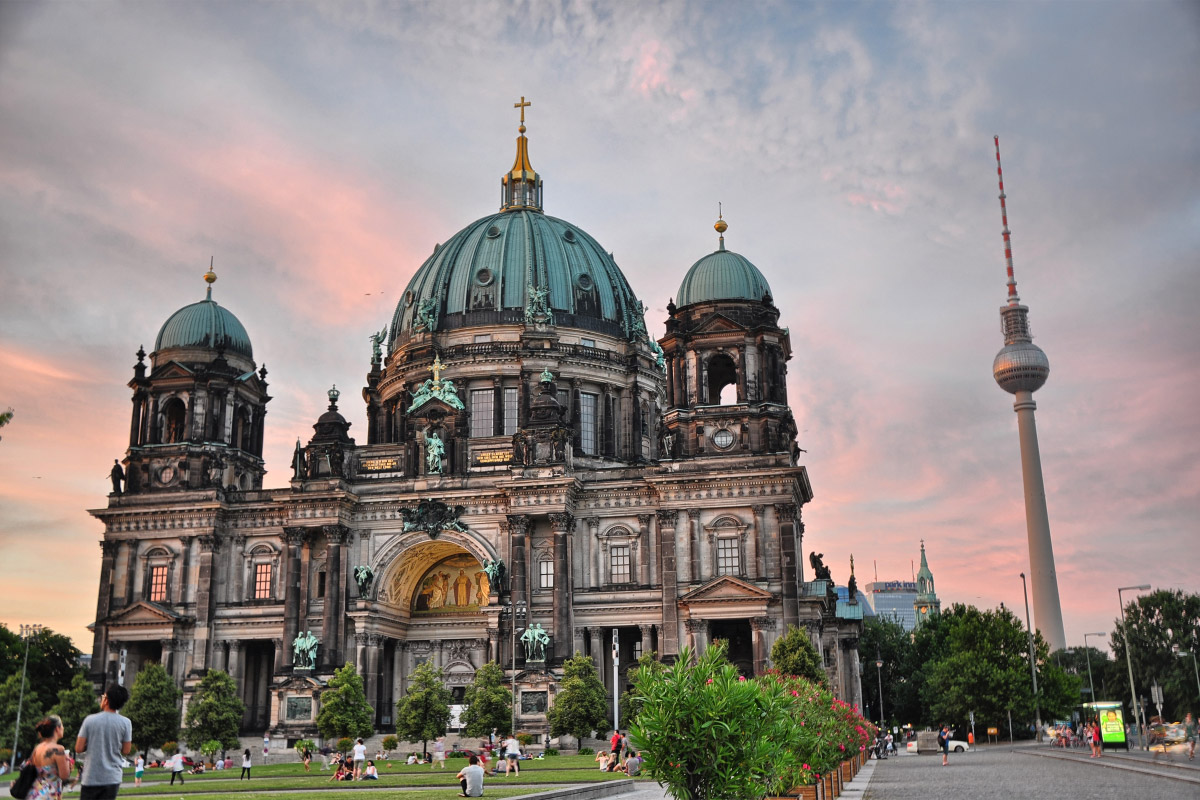
Berlin Cathedral is Germany's largest evangelical church, located on Museum Island in the centre of Berlin. The cathedral was designed by Julius Raschdorf from 1894 to 1905 as the main church for Prussian Protestants and the court church for the ruling Hohenzollern dynasty, replacing the old cathedral whose facades were designed by Karl Schinkel. The Baroque-style building and its dome reach a height of 114 metres. After being damaged during the Second World War, the Cathedral was reconstructed and raised to a height of only 98 metres. During reconstruction work in 1975, the chapel above the vault of the Hohenzollerns, the Memorial Church (Denkmalskirche), was partially blown up and completely dismantled. The restored cathedral was inaugurated on 6 June 1993.
